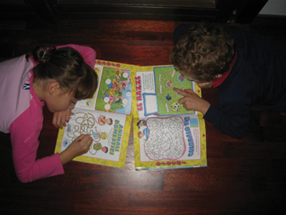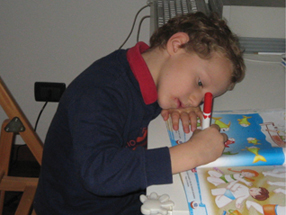|
Posture, which
can be understood as the position of the body in space, represents the
response of the body to the stress by the force of gravity in relationship
to the environment around us and with the objectives of movement.
The
characteristics of posture are based on various factors:
neurophysiological, biomechanical and also emotional and relational. A
correct and functional posture is characterized by the absence of abnormal
asymmetrical muscular tensions and by appropriate relationships among the
various body parts. An
incorrect posture can
instead trigger compensations
in the body that will alter
the physiological structure of the body.
Numerous researchers have
drawn attention on how the posture and vision influence each other. Vision
is therefore considered independently and separately from the rest of the
body,
it is profoundly intrinsic
to the whole system of action of man, his
posture, and his manual skills.
Today, we hear more and more about
the posture problems in school age children, which has become even more
important since the general use of personal computers even during
children's leisure time, to the detriment of more natural movements. The
visual system then has to maintain attention for an extended period of
time at a distance of 25-35 centimetres
from the eyes with an important demand on adaptation and
convergence.
The
habit of keeping very limited distances results in energy loss
with a need for adaptation
and convergence resulting in visual tiredness which can lead to loss of
attention, soreness, pain in the eyes, difficulty
in working for extended periods of time. Maintaining over time an incorrect
posture can hasten the onset of functional and structural problems to the
whole body.
It is common to observe, while studying children, excessive
lateral inclination of the head or notable curving forward of the back.
Also, bringing
a book closer to the face as the difficulty of a text
increases is a common
attitude which is adopted in order to put more attention to the document
to be read, reducing peripheral stimuli.
Harmon, a nineteenth century
scientist, studied extensively the relationship between posture and
prolonged proximal visual activity and determined what should be the
optimal reading distance: the length of the forearm measured from the
elbow to the end of the first phalanx of the
index. |
Ergonomics:
the term comes from the Greek ergo (work) and
nomos
(law, regulation). Influenced by anatomy, physiology, psychology and
engineering, it is the science that studies the planning of domestic and
work environments in order to respect
man's limits and at the same time
strengthen his abilities. There exist various adaptations which allow
the
optimization of the study and work environments with positive outcome
in terms of performance
and results.
In regards to appropriate body position during reading
and writing activities, it is essential first and foremost to have a chair
and a table that have proportionate dimensions to the body of the person.
Often, especially at home, children use chairs and tables that are
proportionate for adults which make it impossible to maintain optimal
stability. It is important that the surface be inclined at about 20°
(maybe with the help of a bookrest) to entice a parallelism between the
reading surface and the face.
While
writing, it is possible to rotate the body from the part opposite to the
writing hand in order to allow writing with more ease, but such rotations
cannot have a width superior to 30°.
The
surface of the chair should have the shape of a pail or a cradle, allowing
movements and a natural distribution of the weight. The height of the seat
has to allow the feet to rest on the floor.
There are exercises to do and precautions to take to
reduce visual stress: for example, raising
the eyes at regular intervals,
when one writes or turns pages during reading, focusing for a few seconds
on an object at a distance allowing the visual system to gain back tone
and dynamism so as to give the body system a chance to recover a stable
position.
In conclusion: it is not enough to have 10 over 10 for an
optimal vision performance, it is also necessary that vision be supported
by good body posture.
An inappropriate
posture, we have to remember, can be linked to various factors:
environmental, visual, psychological, systemic and based on
habits.
An appropriate assessment and a
follow up intervention plan involve many professionals.
The
posturological approach cannot in fact leave out of consideration a
multidisciplinary point of view. |

Woman reading
with correct posture

Children
drawing in the wrong posture

Boy writing
with the wrong posture |


